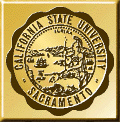FACS 117
COMMUNITY NUTRITION
California
State University, Sacramento
Family and Consumer Science Department
College of Social Sciences
Fall 1999
|
|
|
|
|
|
This class will allow the student to learn some of the principles of community nutrition and apply them in field placement. There are two components to the class:
- Weekly classroom meetings/discussions
- Covers topics such as developing nutrition education materials and program planning.
- Also features guest lecturers from various
community nutrition programs.
- A preceptorship at a community nutrition setting
- Opportunity to learn about one program in depth
- Chance to take on projects that let students practice some of the skills discussed in class and develop other skills.

- To learn principles of community nutrition
- To improve community nutrition related skills
- To learn about programs in community nutrition
The following assignments are due on the dates indicated.
Assignment E-mail
update Placement plan, including goals, objectives, and
proposed timeline 15 Evaluating
Nutrition Education Materials Modifying Health Related Behaviors Adult Learning
Principles Epidemiology
Nutrition
Monitoring System Legislation Oral Report Placement Report Final Project Report Final
Enter your course grading information in the table below.
A Outstanding
achievement; you might want to link to an "A" paper
or project 90 -
100% B Excellent
performance; clearly exceeds course
requirements 80 - 90% C Average 70 - 80% D Passed, but not at
average achievement standards 60 - 70% F Failure to meet
class requirement < 60% Incompletes:
Refer to department's policy for issuing
incompletes.
Students will need an electronic mail account and computer access to the Web. All CSUS students enrolled in one or more units can create a SacLink account for electronic mail and Internet services. Although a home computer with a high speed modem running Netscape or Internet Explorer would be beneficial, students can use the Web from one of the campus student labs.
Computing RecommendationsYou should be comfortable using a computer and willing to browse the Web. This class requires online class participation on the Web assignments and electronic discussions.
You need:
- Macintosh compatible with System 7.1 or higher or Windows compatible 486 running Windows 3.1, Windows NT, or Windows 95.
- 16MB of RAM, preferably 32MB
- 19.6K or faster modem - preferably 28.8K
- Microsoft Internet Explorer or Netscape 3.0 (or higher)
- SacLink or other Internet Account
- Word processing skills
Students need an electronic mail account and computer access to the Web. All CSUS students enrolled in one or more units can create a SacLink account for electronic mail and Internet services. Although a home computer with a high speed modem running Netscape or Internet Explorer would be beneficial, students can use the Web from one of the campus student labs.
Required: The text for the course this semester is: Boyle, Marie and Diane Morris, COMMUNITY NUTRITION IN ACTION: AN ENTREPRENEURIAL APPROACH: Second Edition. New York: West Publishing Co, 1998. Other materials will be distributed in class, via the website, or placed on library reserve.
You can purchase books through the Hornet Bookstore. Check their Distance and Distributed Learning page at http://www.bookstore.csus.edu/bookstore/distance/ for ordering information.
